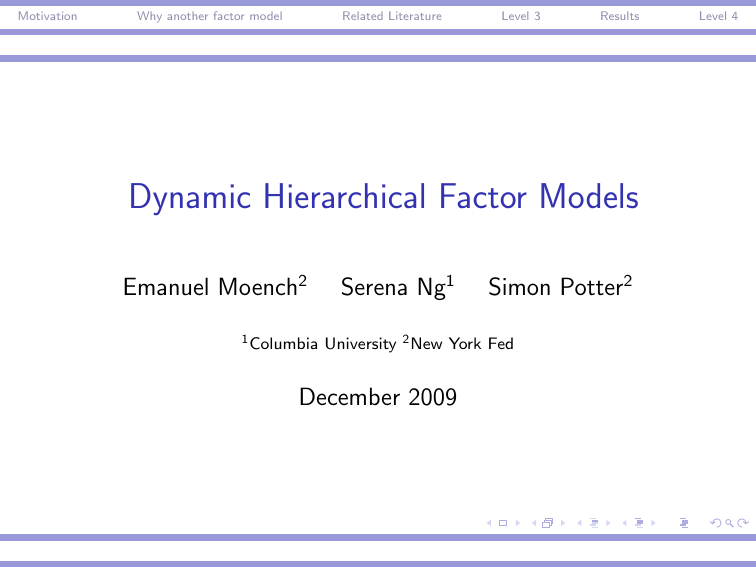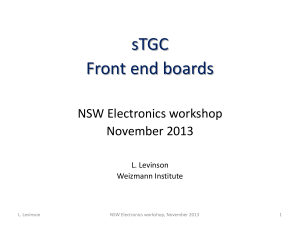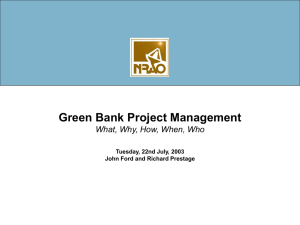Dynamic Hierarchical Factor Models
advertisement

Motivation
Why another factor model
Related Literature
Level 3
Results
Dynamic Hierarchical Factor Models
Emanuel Moench2
1 Columbia
Serena Ng1
Simon Potter2
University 2 New York Fed
December 2009
Level 4
Motivation
Why another factor model
Related Literature
Level 3
Results
Motivation
A multi-level (hierarchical) factor model:
• A large panel of data organized by B blocks,
• e.g. Production, Employment, Demand, Housing, . . .
• each block b has Nb series, Nb large
• N=
PB
b=1 Nb
Level 4
Motivation
Why another factor model
Related Literature
Level 3
Results
Motivation
A multi-level (hierarchical) factor model:
• A large panel of data organized by B blocks,
• e.g. Production, Employment, Demand, Housing, . . .
• each block b has Nb series, Nb large
• N=
PB
b=1 Nb
• Each block can be divided into sub-blocks
• e.g. sub-blocks of Demand: Retail Sales, Auto Sales,
Wholesale Trade
Level 4
Motivation
Why another factor model
Related Literature
Level 3
Results
Motivation
A multi-level (hierarchical) factor model:
• A large panel of data organized by B blocks,
• e.g. Production, Employment, Demand, Housing, . . .
• each block b has Nb series, Nb large
• N=
PB
b=1 Nb
• Each block can be divided into sub-blocks
• e.g. sub-blocks of Demand: Retail Sales, Auto Sales,
Wholesale Trade
• Within block variations due to block-level factors
• Between block variations due to common factors
• Idiosyncratic noise
Level 4
Motivation
Why another factor model
Related Literature
Level 3
A Three Level Model
Level 1: For b = 1, . . . , B, i = 1, . . . , Nb ,
Xbit = ΛG .bi (L)Gbt + eXbit ,
ψX .bi (L)eXbit = Xbit ,
Results
Level 4
Motivation
Why another factor model
Related Literature
Level 3
A Three Level Model
Level 1: For b = 1, . . . , B, i = 1, . . . , Nb ,
Xbit = ΛG .bi (L)Gbt + eXbit ,
ψX .bi (L)eXbit = Xbit ,
Level 2: For j = 1, . . . kGb
Gbjt = ΛF .bj (L)Ft + eGbjt ,
ψG .bj (L)eGbjt = Gbjt .
Results
Level 4
Motivation
Why another factor model
Related Literature
Level 3
A Three Level Model
Level 1: For b = 1, . . . , B, i = 1, . . . , Nb ,
Xbit = ΛG .bi (L)Gbt + eXbit ,
ψX .bi (L)eXbit = Xbit ,
Level 2: For j = 1, . . . kGb
Gbjt = ΛF .bj (L)Ft + eGbjt ,
ψG .bj (L)eGbjt = Gbjt .
Level 3: For r = 1, . . . kF
ψF .r (L)Frt = Frt ,
2
, σG2 b j , σF2r ).
Xbit , Gbjt , Fkt ∼ iid(0, σXbi
Results
Level 4
Motivation
Why another factor model
Related Literature
Level 3
Results
A Four Level Model
For s = 1, . . . , Sb , b = 1, . . . , B, i = 1, . . . , Nb :
Zbsit
Hbst
Gbt
ψF .r (L)Frt
=
=
=
=
ΛH.bsi (L)Hbst + eZbsit , Individual Series
ΛG .bs (L)Gbt + eHbst ,
Subblock Factors
ΛF .b (L)Ft + eGbt ,
Block factors
Frt
Aggregate factors
with dyanmics
ψZ .bsi (L)eZbsit = Zbsit
ΨH.bs (L)eHbst = Hbst
ΨG .b (L)eGbt = Gbt
Level 4
Motivation
Why another factor model
Related Literature
Level 3
Results
Why another factor model?
1) Block structure arises naturally in many economic and
financial analyses:
• real activity: production, employment, demand, housing
• Global, regional, and country level variations
• Country, regions, state level variations
• Aggregate, industry, firm level variations in stock returns
Level 4
Motivation
Why another factor model
Related Literature
Level 3
Results
2) Can put structure on the model through
• Ordering of the variables within block
• Ordering of the blocks
Xbt = ΛGb.0 Gbt + . . . + ΛGb.sGb Gb,t−sGb + eXbt
where
1
ΛG .b0 =
x
x
0
...
x
λG .b01 · · ·
Easy interpretation of factors
0
0
1
λG .b0kb
Level 4
Motivation
Why another factor model
Related Literature
Level 3
Results
3) Addresses a limitation of level two models:
e.g. kG = kF = 1:
xibt = λG .ib (λF .b Ft + eG .bt ) + eX .ibt
= λib Ft + vibt
vibt = λG .ib eG .bt + eX .ibt .
Ignoring block level variations gives a level 2 model:
xit = λi Ft + vit
with E (vit vjt ) 6= 0 if i, j both belong to b.
A multi-level model controls for these ‘quasi-common’
variations.
Level 4
Motivation
Why another factor model
Related Literature
Level 3
Results
4) State Space Framework
• Data sampled at mixed frequencies
• Missing values
• Internally coherent (no auxiliary forecasting model
necessary)
Level 4
Motivation
Why another factor model
Related Literature
Level 3
Results
5) Advantages and Uses
• Allows block and aggregate level analysis but still
achieves dimension reduction
• Jointly estimates block level and aggregate factors
• Can be used for monitoring, counterfactuals, assess
relative importance of shocks etc.
Level 4
Motivation
Why another factor model
Related Literature
Level 3
Results
Application: Monitoring Real Activity in the US
• Data are released in various blocks throughout the month
• Releases broadly correspond to economic categories
• Block level factors are of independent interest
• Real time monitoring of Ft and Gbt
• More manageable than monitoring hundreds of series
Level 4
Motivation
Why another factor model
Related Literature
Level 3
Results
Related Work
1 Diebold, Li, Yue (JOE 2008): Three level model for
international bond yields
• Two step: estimate country level factors using OLS (with
loadings fixed), then estimate global factors via MCMC.
• Limitations:
• single factor at block and global levels
• Information from global factors not taken into account
when sampling country (block-level) factors.
• Global factors do not account for sampling uncertainty
of block factors.
Our one-step estimation solves both issues.
Level 4
Motivation
Why another factor model
Related Literature
Level 3
Results
2 Kose-Otrok-Whiteman (AER 2003): three level model
• For each unit i in country b:
xbit = ci Ft + dbi eGbt + ebit
• Top down vs. bottom up (Gb vs eGb )
• single factors
• static loadings
• (N · kF + N · kG ) vs (kG · kF + N · kG ) parameters.
• Hierarchical structure: kG << N
• for each i, need to invert a T × T matrix at each draw.
Level 4
Motivation
Why another factor model
Related Literature
Level 3
Results
3 Hierarchical loadings vs. hierarchical factors
• Common factors across blocks, loadings differ by blocks
• Spatial factor models: loadings vary by distance
• Not a natural way of analyzing macroeconomic data
• All shocks are global, sensitivity to global shocks differ by
regions
Level 4
Motivation
Why another factor model
Related Literature
Level 3
Results
4 Principal components
i One step estimation of Ft (level two)
ii One step estimation of Ft and eGbt (but no Gbt )
et ):
iii Sequential estimation: Fet (G
et
• For each b, first estimate Gbt , then estimate Ft from G
• Ignore dynamic dependence of Gbt on Ft .
• Needs auxiliary equations for forecasting
iv Block level dynamic principal components?
Require N and T large.
Level 4
Motivation
Why another factor model
Related Literature
Level 3
Results
Many other seemingly related state space models.....
Unique features of our dynamic hierarchical model:
• Coherent treatment of factors at different levels
• Produce factor estimates at both the block-level and
aggregate levels
• Multiple factors at each level
• Hierarchical structure of factors, not loadings
• Analyze up to 4 levels, each with possibly multiple factors
• Can handle (but does not require) large N or T .
Level 4
Motivation
Why another factor model
Related Literature
Level 3
Results
Level 4
The State Space Form
Block-Level Factors:
Gbt = ΛF .b0 Ft + ΛF .b1 Ft−1 + . . . + ΛF .blF Ft−lF + eGbt ,
ΨG .b (L)eGbt = Gbt .
implies (pseudo) measurement equation
ΨG .b (L)Gbt = ΨG .b (L)ΛF .b (L)Ft + Gbt .
Transition equation:
ΨF (L)Ft = Ft ,
Motivation
Why another factor model
Related Literature
Level 3
Results
Observed data:
Xbt = ΛGb.0 Gbt + . . . + ΛGb.sGb Gb,t−sGb + eXbt
ψX .bi (L)eXbit = Xbit ,
implies the individual level measurement equation
ΨX .b (L)Xbt = ΨX .b (L)ΛG .b (L)Gbt + Xbt .
Measurement equation from level 2 becomes the transition
equation for state variable in level 1
Gbt = αF .bt + ΨG .b1 Gbt−1 + . . . + ΨG .bqGb Gbt−qGb + Gbt .
Level 4
Motivation
Why another factor model
Related Literature
Level 3
Results
Observed data:
Xbt = ΛGb.0 Gbt + . . . + ΛGb.sGb Gb,t−sGb + eXbt
ψX .bi (L)eXbit = Xbit ,
implies the individual level measurement equation
ΨX .b (L)Xbt = ΨX .b (L)ΛG .b (L)Gbt + Xbt .
Measurement equation from level 2 becomes the transition
equation for state variable in level 1
Gbt = αF .bt + ΨG .b1 Gbt−1 + . . . + ΨG .bqGb Gbt−qGb + Gbt .
with time-varying intercept
αF .bt = ΨG .b (L)ΛF .b (L)Ft .
Level 4
Motivation
Why another factor model
Related Literature
Level 3
Results
Identification
• var (Gb ) and var (F ) are diagonal
• Block factor loadings
ΛG 0
1
=
x
x
λGb01
0
..
.
x
···
0
0
1
λGb0kb
• Common factor loadings
ΛF 0
1
=
x
x
λF .01
0
...
x
···
0
0
1
λF .0KF
Level 4
Motivation
Why another factor model
Related Literature
Level 3
Results
MCMC
Let Σ = (ΣF , ΣG , ΣX ), Ψ = (ΨF , ΨG , ΨX ), Λ = (ΛG , ΛF )
1
2
3
4
Use PCs as initial estimates of {Gt } and {Ft }, get initial
values for Λ, Ψ, Σ
Conditional on Λ, Ψ, Σ and {Ft }: draw {Gbt } block by
block using Carter-Kohn algorithm modified to allow for
time varying intercept
Conditional on Λ, Ψ, Σ and {Gt }: draw {Ft }
Conditional on {Ft } and {Gt }: draw Λ, Ψ, and Σ
assuming conjugate priors
Level 4
Motivation
Why another factor model
Related Literature
Level 3
Results
Step 2: allows lower level factors to depend on the factors at
the next level.
Level two transition equation: αF .bt = ΨGb (L)ΛF (L)Ft
Gbt = αF .bt + ΨGb.1 Gbt−1 + . . . ΨGb.qGb Gbt−qGb + Gbt
• The time-varying intercept αF .bt is known given Ψ, Λ,
{Ft }:
• Modify standard updating and smoothing equations for
Gbt to take this into account.
• Any filtering/sampling method for linear state space
models can be adapted to hierarchical models this way.
Level 4
Motivation
Why another factor model
Related Literature
Level 3
Results
Data Release Calendar June 2009
June 6
Wholesale
Trade
(WT)
June 2
ISM
Manufacturing
Survey
(ISM)
Establishment
Survey
(ES)
Auto Sales
(AUTO)
Household
Survey
(HS)
June 17
Housing Starts
(H-Starts)
June 1
Industrial Production
(IP)
June 25
Capacity Utilization
(CU)
New Home Sales
(H-NewSales)
June 15
June 30
June 3
June 12
June 19
June 26
Manufacturing
Shipments,
Inventories,
and Orders
(DG)
Retail Sales
(RS)
Philadelphia
Business
Outlook
Survey
(PhilaFed)
Existing Home
Sales
(H-ExistSales)
Chicago
Midwest Mfg.
Survey
(ChicagoFed)
Level 4
Motivation
Why another factor model
Related Literature
Level 3
Results
Level 4
A Three Level Model: 315 series
Block
1 CU
2 IP
3 ES
4 HS
5 MS
6 DG
N
25
38
82
92
35
60
Variable Ordered First
Machinery
Durable Consumer Goods
All Employ: Wholesale Trade
Civ. Labor Force: Men: 25-54
PMI Composite Index
Inventories: Machinery
Parameters:
• kF = 1, kG = 2
• sF = 2, sG = 2
• qX = qG = qF = 1
Variable Ordered Second
Motor Vehicles and Parts
Nondurable Consumer Goods
Avg Wkly Earnings: Construction
Unemp. Rate Full-Time Men Worker
Phila FRB General Activity Index
Mfrs’ Unfilled Orders: Machinery
Motivation
Why another factor model
Related Literature
Level 3
Table 4: Level 3, 6 Block Model
Block
CU: 1
CU: 1
IP: 2
IP: 2
ES: 3
ES: 3
HS: 4
HS: 4
MS: 5
MS: 5
DG: 6
DG: 6
Factor
1
j
1
2
1
2
1
2
1
2
1
2
1
2
b G .bj
Ψ
0.373
-0.122
0.170
-0.140
0.052
-0.160
0.198
-0.069
0.436
0.059
-0.013
-0.009
ΨF .k
0.880
2
σ
bbj
0.064
0.057
0.015
0.047
0.015
0.031
0.137
0.056
0.824
0.111
0.030
0.030
σ
bF2 .k
0.061
S.E
0.113 0.021
0.091 0.016
0.110 0.007
0.089 0.017
0.137 0.007
0.115 0.010
0.095 0.031
0.096 0.010
0.128 0.091
0.093 0.024
0.172 0.007
0.175 0.006
S.E.
0.040 0.017
Results
Level 4
Motivation
block
1 CU:
2 IP:
3 ES:
4 HS:
5 MS:
6 DG:
Why another factor model
shareF
0.303
0.321
0.279
0.081
0.117
0.101
Related Literature
Decomposition of
Estimates
shareG shareX
0.144 0.553
0.131 0.549
0.114 0.607
0.150 0.769
0.222 0.661
0.123 0.777
Level 3
Results
Variance
shareF
0.069
0.075
0.073
0.034
0.056
0.044
S.E.
shareG
0.021
0.021
0.020
0.013
0.033
0.014
shareX
0.055
0.058
0.056
0.026
0.031
0.035
Level 4
Motivation
Why another factor model
Related Literature
Level 3
Results
Figure: 6 Block Model of Real Activity:
Three Level Six Block Model for Output
3
2
1
0
−1
−2
−3
−4
−5
−6
1992
F̂
F̃
1994
1996
1998
2000
2002
2004
2006
2008
2010
Level 4
Motivation
Why another factor model
Related Literature
Level 3
Results
Is Fet picking up block-level common variations?
et
• Bai and Ng (2002): IC2 finds 2 factors common to G
ert on Fbt . Let e
• for r = 1, . . . kF , regress F
ert be the residuals
bt
• regress e
ert on G
ekt that are not genuinely
• R 2 measures variations in F
common: orthogonal to our Fbt but correlated with Gbt .
Level 4
Motivation
Why another factor model
Related Literature
Table 5: Correlation
k b
1 3
2 3
2 3
2 5
3 5
4 4
5 1
5 2
7 6
Level 3
bbkt and e
Between G
ert|Fb
j
ρ
2 0.17
1 0.20
2 0.32
1 0.13
1 0.27
2 0.16
2 0.60
2 0.31
2 0.15
Results
Level 4
Motivation
Why another factor model
Related Literature
Level 3
Results
Level 4
Four Level Model: 447 Series
Block
Production
Employment
Demand
Housing
Mfg Surveys
subblock
CU
IP
DG
ES
HS
RS
WS
AUTO
H-STARTS
H-NEWSALES
H-EXISTSALES
ISM
PHILAFED
CHICFED
N
25
38
60
82
92
30
54
4
24
5
4
9
21
5
KGb
1
1
1
1
1
1
1
1
1
1
1
1
1
1
KHbs
2
2
2
2
2
2
2
1
2
1
1
1
1
1
Variable Ordered First
Capacity Utilization
IP: Durables
Manufacturers’ Inventorie
All Employees: Wholesale
Civilian Labor Force: Men
Retail Sales: General Mer
Merchant Wholesalers: S
Domestic Car Retail Sale
Housing Starts: 1-Unit: W
New 1-Family Houses So
NAR Total Existing Hom
ISM Mfg: PMI Composit
Phila FRB Bus Outlook:
Chicago FRB: Midwest M
Motivation
Why another factor model
3
Related Literature
Level 3
Results
Four Level Model for Real Activity with 5 Blocks and 14 Subblocks: F̂ and all Ĝ
2
1
0
−1
−2
−3
−4
−5
−6
1992
Ĝ1
Ĝ2
Ĝ3
Ĝ4
Ĝ5
F̂
1994
1996
1998
2000
2002
2004
2006
2008
2010
Level 4
Motivation
Why another factor model
Related Literature
Level 3
Results
Decomposition of Variance
block
Output
Output
Output
Employment
Employment
Demand
Demand
Demand
Housing
Housing
Housing
Mfg Surveys
Mfg Surveys
Mfg Surveys
sub-block
IP
CU
DG
HS
ES
RS
WT
AUTO
H-starts
H-newsales
H-existsales
ISM
PhilaFed
ChicagoFed
shareF
0.090
0.089
0.022
0.042
0.015
0.030
0.012
0.018
0.005
0.002
0.003
0.035
0.010
0.022
shareG
0.115
0.113
0.026
0.090
0.033
0.073
0.028
0.049
0.069
0.030
0.038
0.161
0.045
0.071
shareH
0.176
0.161
0.180
0.226
0.171
0.212
0.153
0.393
0.176
0.285
0.626
0.248
0.197
0.461
shareX
0.619
0.637
0.773
0.642
0.782
0.685
0.806
0.539
0.750
0.683
0.333
0.556
0.747
0.446
Level 4
Motivation
Why another factor model
Related Literature
Level 3
Results
Monitoring in a data rich environment
• Update state of the block as new information in sub-block
arrives
• ‘Predict’ state of blocks for which new data are not yet
released
• Use updated and predicted block factors to update
aggregate factors
Level 4
Motivation
Why another factor model
Related Literature
Level 3
Results
Figure: Four Level Model with 5 Blocks and 14 Subblocks
F̂
0
−0.1
−0.2
−0.3
−0.4
−0.5
−0.6
−0.7
−0.8
−0.9
Feb07
Monthly update
Continuous update
Jun07
Sep07
Dec07
Apr08
Jul08
Oct08
Jan09
May09
Aug09
Level 4
Motivation
Why another factor model
Related Literature
Level 3
Results
Figure: Demand Block
Ĝ3 : Demand
0.4
0.2
0
−0.2
−0.4
−0.6
−0.8
−1
Feb07
Monthly update
Continuous update
Jun07
Sep07
Dec07
Apr08
Jul08
Oct08
Jan09
May09
Aug09
Level 4
Motivation
Why another factor model
Related Literature
Level 3
Results
Figure: Housing
Ĝ4 : Housing
0.1
0
−0.1
−0.2
−0.3
−0.4
−0.5
−0.6
Feb07
Monthly update
Continuous update
Jun07
Sep07
Dec07
Apr08
Jul08
Oct08
Jan09
May09
Aug09
Level 4
Motivation
Why another factor model
Related Literature
Level 3
Results
Figure: Manufacturing
Ĝ5 : Mfg Surveys
0.5
0
−0.5
−1
−1.5
Feb07
Monthly update
Continuous update
Jun07
Sep07
Dec07
Apr08
Jul08
Oct08
Jan09
May09
Aug09
Level 4
Motivation
Why another factor model
Related Literature
Level 3
Results
A Housing Model
Three features of the model:
i) Distinguishes regional from national variations
• 4 Census regions: North-East, West, Mid-West, South.
ii) Distinguishes house price from housing market variations,
i.e. use data on prices and volume.
iii) Combines data that are sampled at monthly and quarterly
frequencies and available over different time spans.
iv) Allows observed factors.
Level 4
Motivation
Why another factor model
Related Literature
Level 3
Regional Series
Price data
Median Sales Price of Single Family Existing Homes
Single Family Median Home Sales Price
Average Existing Home Prices
Average New Home Prices
Conventional Mortgage Home Price Index
OFHEO Purchase-only Index
OFHEO Home Prices
Volume data
New 1-Family Houses Sold
New 1-Family Houses For Sale
Single-Family Housing Units Under Construction
Multifamily Units Under Construction
Homeownership Rate
Homeowner Vacancy Rate
Rental Vacancy Rate
Results
Level 4
Source
Frequency
NAR
CENSUS
NAR
NAR
FHLMC
OFHEO
OFHEO
mly
qly
qly
qly
qly
mly
qly
CENSUS
CENSUS
CENSUS
CENSUS
CENSUS
CENSUS
CENSUS
mly
mly
mly
mly
qly
qly
qly
Motivation
Why another factor model
Related Literature
Level 3
National Series
Price data
Median Sales Price of Single Family Existing Homes
Median Sales Price of Single Family New Homes
Single Family Median Home Sales Price
Average Existing Home Prices
Average New Home Prices
S&P/Case-Shiller Home Price Index
Conventional Mortgage Home Price Index
OFHEO Purchase-only Index
OFHEO Home Prices
Volume data
New 1-Family Houses For Sale
Housing Units Authorized by Permit: 1-Unit
Multifamily Units Under Construction
Multifamily Permits US
Multifamily Starts US
Multifamily Completions
Results
Level 4
Source
Frequency
NAR
Census
CENSUS
NAR
CENSUS
S&P
FHLMC
OFHEO
OFHEO
mly
mly
qly
mly
mly
qly
qly
mly
qly
CENSUS
CENSUS
CENSUS
CENSUS
CENSUS
CENSUS
mly
mly
mly
mly
mly
mly
Motivation
Why another factor model
Related Literature
Data used in this study:
• Regional level
• 7 price series
• 14 price and volume series.
• National level
• 9 price series
• 17 price and volume series.
Level 3
Results
Level 4
Motivation
Why another factor model
Related Literature
Level 3
Results
Three Level Dynamic Factor model
For each series i in region b:
Xbit = ΛG .bi (L)Gbt + eXbit .
Let Gt = (G1t G2t . . . GBt )0 the set of regional factors
Let Yt be observed aggregate indices:
Gt
eGt
= ΛF (L)Ft +
Yt
eYt
Identification:
• ΛGb (0) is lower triangular with 1’s on the diagonal
• ΛF (0) is lower triangular with 1’s on the diagonal.
Level 4
Motivation
Why another factor model
Related Literature
Level 3
Results
Level 4
Figure 2
NAR
CMHPI
4
2
3
1.5
2
1
1
0.5
0
0
−1
−0.5
−2
−1
F
F
p
−3
p
−1.5
BLS
−4
−5
75
CMHPI
−2
80
85
90
95
100
105
110
−2.5
75
80
85
90
OFHEO
95
100
105
110
100
105
110
Case−Shiller
2
1.5
1
1
0.5
0
0
−0.5
−1
−1
−2
−1.5
F
F
p
p
−2
OFHEO
−3
Case−Shiller
−2.5
−4
75
80
85
90
95
100
105
110
−3
75
80
85
90
95
Motivation
Why another factor model
Related Literature
Level 3
Results
Figure 4: House Price vs. Housing Factor
1.5
1
0.5
0
−0.5
−1
Fp
Fpq
−1.5
−2
−2.5
75
80
85
90
95
100
105
110
Level 4
Motivation
Why another factor model
Related Literature
Level 3
Results
Conclusion
No model can serve all needs!
A multilevel state space model with unique features
• Hierarchy in factors of up to 4 levels
• Explicitly model within block correlations
• Multiple factors at each level
• Dynamic evolution of the factors modeled in an internally
coherent fashion
• We provide algorithms for estimation and monitoring in a
data rich environment
• Wide range of applications.
Level 4
Motivation
Why another factor model
Related Literature
Thank You!
Level 3
Results
Level 4





